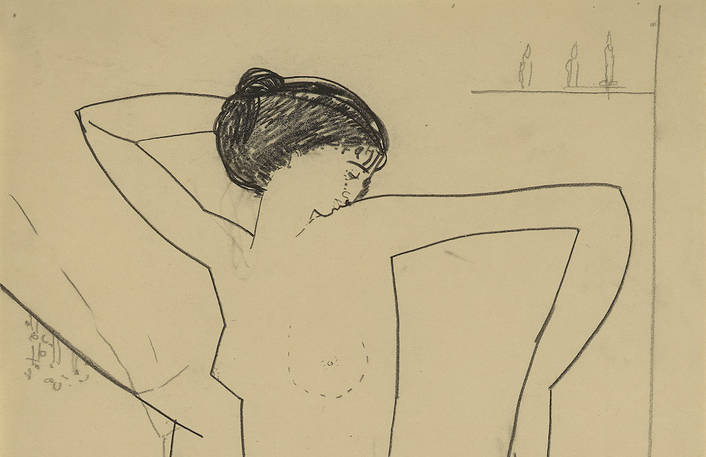New York reporters are quick in identifying cultural events of great significance, as in the case of “Modigliani Unmasked” at the Jewish Museum on Fifth Avenue. The centenary museum, has opened its doors to all those who want to see the exceptional collection of Amedeo Mogliani’s early works. The line that winds around the corner all the way down the block to Fifth Avenue, confirms that the public’s interest is great and that people flock to it week after week.
The tremendous interest in the exhibit—a showcase curated by Mason Klein who wanted to present the Italian Jewish artist in a different light—has forced the museum to stay open for longer hours. “Modigliani Unmasked” is scheduled to last until February 4, 2018.
Modigliani’s work returns to New York sixty six years after a retrospective held at MoMA back in 1951; the show at the Jewish Museum features the first works by the artist, made in his twenties upon moving to Paris, and it’s mostly comprised of drawings.
Born in Livorno in 1884, by an Italian father and a French mother, the artist moved to Paris in 1906 where he found himself, for the first time, face to face with fierce ostracism, due to his Judaism. That had never happened to him before back in Italy.
The works on display, mostly coming from the private collection of Dr. Paul Alexandre, an old friend of “Modi’s” from the years back in Paris, are comprised of 130 drawings, 12 paintings and 7 sculptures and are grouped in the exhibition halls by theme.
Located in the Museum Mile on Fifth Avenue, the Jewish Museum, even if small in size, has become the focus of the cultural attention of New Yorkers and international visitors alike, the many languages spoken by them are a way to tell they are coming from all corners of the world, thanks to “Modigliani Unmasked.”
What the museum offers is the opportunity to discover lesser known works, pieces that are little known just as the emerging artist from Livorno himself was during his first years in Paris. There he had the chance to find himself and explore different cultures. Mostly, Modigliani admired African, Asian, Greek and Egyptian art, all identifiable in the works he completed at the age of thirty, works that addressed ancient art by personalizing his representation of the caryatids. Modigliani, in opposition to their classic female representation, re-designed them and portrayed them in his drawings as both women and men but also as ambiguous beings.
The city of Paris, at the beginning of the 1900s, was characterized by waves of anti-semitism and
xenophobia, and Modigliani couldn’t feel at home, despite being at ease with both the classic Italian and French cultures and both languages.
Charming and troubled, Modigliani did not live a serene life, mostly due to tuberculosis which killed him in 1920, when he was only 36 years old. On January 25th, the day after his death, his lover and model, Jeanne Hébuterne, desperate for the loss and pregnant with his child, committed suicide.
Reports from those years relate that the artist from Livorno, arrived in Paris with great expectations and he loved to stand out from the group of Jewish artists he was a part of. Out in public, he liked to introduce himself like this: “My name is Modigliani and I am Jewish.” This was his way of protesting assimilation.
Broadway and Hollywood both portrayed Modigliani’s life and career, with a long standing off-Broadway show and with “Montparnasse 19,” a film that’s almost sixty years old. More recently, back in 2004, a film came out with Andy Garcia playing Modigliani himself.
The Jewish Museum – located on Fifth Avenue & 92nd Street – has also put together an audio tour, a program of lectures and meetings, and a catalogue (172 pages with 165 photographs) edited by Yale University Press.
For information call


